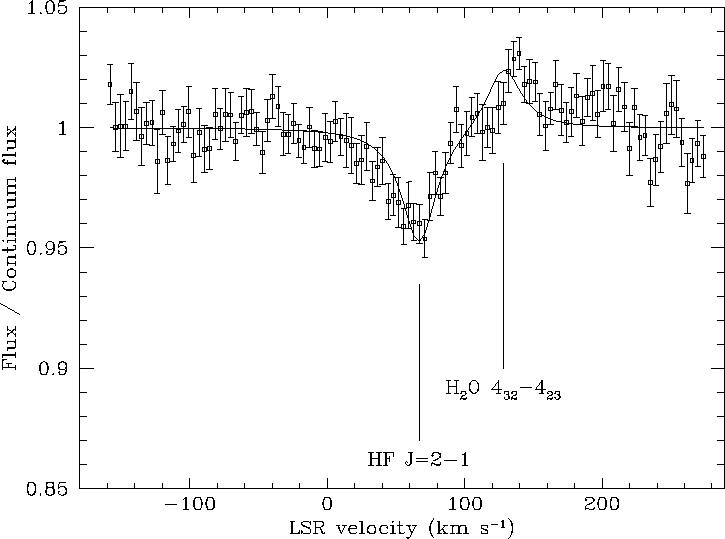
The Following text was taken from ESA Press Release 12 August 1997
ASTRONOMERS DISCOVER FLUORIDE MOLECULES IN INTERSTELLAR SPACE
A team of astronomers from the United States and Germany has discovered trace amounts of hydrogen fluoride gas in the near vacuum of interstellar space, using the European Space Agency's Infrared Space Observatory satellite, ISO, which was launched in November 1995.
Although approximately one hundred different kinds of molecule have been detected in interstellar space over the past 30 years, the discovery of hydrogen fluoride marks the first time that a molecule containing fluorine has been detected in an interstellar gas cloud. The discovery was reported in an article that is to appear in the Astrophysical Journal Letters.
The astronomers searched for hydrogen fluoride molecules within a giant cloud of interstellar gas located near the centre of the Milky Way galaxy. The new observations were carried out in March with the Long Wavelength Spectrometer, one of four instruments on board ISO. Looking in the far-infrared region of the electromagnetic spectrum, the astronomers observed the telltale signature of absorption by trace amounts of hydrogen fluoride gas.
"Because the Earth's atmosphere is completely opaque to far-infrared radiation, the observations that we carried out are possible only from space," said Professor David Neufeld of the Department of Physics and Astronomy, Johns Hopkins University, Baltimore, leader of the team that reported the finding. "The ISO satellite has opened up an exciting new window on the universe by allowing us to observe at far-infrared wavelengths." The characteristic wavelength at which hydrogen fluoride molecules absorb radiation is approximately one eighth of a millimetre, much larger than the wavelength of visible light but much smaller than the wavelengths typically used for radio and television communications.
In concentrated liquid form, hydrogen fluoride - or hydrofluoric acid as it is known when dissolved in water - is familiar to laboratory chemists as an extremely dangerous and corrosive acid that dissolves glass and severely burns human tissues. The gas cloud in which hydrogen fluoride molecules were discovered lies approximately 20,000 light years from Earth, in the Southern constellation Sagittarius. Known to astronomers as Sagittarius B2, the gas cloud is composed primarily of hydrogen molecules. As in other clouds of interstellar gas, the environment in Sagittarius B2 is very extreme by terrestrial standards, with temperatures less than minus 220 Celsius, and pressures more than one hundred million million times smaller than the atmospheric pressure on Earth. And although the hydrogen fluoride is less than one thousand millionth as abundant as the hydrogen, the sensitivity of the ISO spectrometers made its detection possible.
"This discovery gives us the opportunity to study the chemistry of fluoride molecules in the frigid conditions that characterise the near vacuum of interstellar space," says Neufeld. "One of the key questions is how these molecules were formed. Our analysis suggests that the hydrogen fluoride we detected was produced by direct chemical reactions between fluorine atoms and hydrogen molecules. Unlike most atoms, fluorine atoms are extremely reactive and attack the relatively inert hydrogen molecules that are the principal constituent of the interstellar gas. The result is hydrogen fluoride."
The members of the team that made the discovery of hydrogen fluoride are Neufeld, Professors Jonas Zmuidzinas and Thomas Phillips of the California Institute of Technology, and Dr Peter Schilke of the Max-Planck Institute for Radio Astronomy in Bonn, Germany. The participation of Neufeld, Zmuidzinas and Phillips as guest observers on ISO was supported by the National Aeronautics and Space Administration, NASA.
The Infrared Space Observatory is a satellite built and launched by ESA, with instruments supplied by Principal Investigators in France, Germany, the Netherlands and the United Kingdom. ISO is operated by ESA with the support of NASA.
The Long-Wavelength spectrometer was built by a consortium of scientists and engineers from Canada, France, Italy, the UK and the USA, led by Professor Peter Clegg of Queen Mary and Westfield College, University of London, England.
INFRARED PROCESSING AND ANALYSIS CENTER